Assessment of Large-Scale Seasonal River Morphological Changes in Ayeyarwady River Using Optical Remote Sensing Data
Abstract
:1. Introduction
2. Materials and Methods
2.1. Study Area
2.2. Methods
2.2.1. Data
2.2.2. Creating Pre-Monsoon and Post-Monsoon Composite
2.2.3. Seasonal River Morphological Changes

2.2.4. Field Validation
2.2.5. Developing a Web-Interface
2.3. Service Planning Approach
3. Results
3.1. Field Validation and Accuracy Assessment
3.2. Spatio-Temporal Changes in Erosion/Accretion Areas
3.3. Changes in River Width
3.4. Dancing Rivers—The Ayeyarwady River Morphological Monitoring System
4. Discussion
5. Conclusions
Author Contributions
Funding
Data Availability Statement
Acknowledgments
Conflicts of Interest
References
- Grabowski, R.C.; Surian, N.; Gurnell, A.M. Characterizing Geomorphological Change to Support Sustainable River Restoration and Management: Characterizing Geomorphological Change in Rivers. WIREs Water 2014, 1, 483–512. [Google Scholar] [CrossRef]
- Lewin, J.; Brewer, P.A.; Wohl, E. Fluvial Geomorphology. In Reference Module in Earth Systems and Environmental Sciences; Elsevier: Amsterdam, The Netherlands, 2018; ISBN 978-0-12-409548-9. [Google Scholar]
- Abbas, N.; Subramanian, V. Erosion and Sediment Transport in the Ganges River Basin (India). J. Hydrol. 1984, 69, 173–182. [Google Scholar] [CrossRef]
- Syvitski, J.P.M.; Vörösmarty, C.J.; Kettner, A.J.; Green, P. Impact of Humans on the Flux of Terrestrial Sediment to the Global Coastal Ocean. Science 2005, 308, 376–380. [Google Scholar] [CrossRef] [PubMed]
- Kummu, M.; Varis, O. Sediment-Related Impacts Due to Upstream Reservoir Trapping, the Lower Mekong River. Geomorphology 2007, 85, 275–293. [Google Scholar] [CrossRef]
- Kale, V.S.; Hire, P.; Baker, V.R. Flood Hydrology and Geomorphology of Monsoon-Dominated Rivers: The Indian Peninsula. Water Int. 1997, 22, 259–265. [Google Scholar] [CrossRef]
- Kale, V.S. Fluvial Geomorphology of Indian Rivers: An Overview. Prog. Phys. Geogr. Earth Environ. 2002, 26, 400–433. [Google Scholar] [CrossRef]
- Keskinen, M.; Guillaume, J.H.A.; Kattelus, M.; Porkka, M.; Räsänen, T.A.; Varis, O. The Water-Energy-Food Nexus and the Transboundary Context: Insights from Large Asian Rivers. Water 2016, 8, 193. [Google Scholar] [CrossRef] [Green Version]
- WWF. The Ayeyarwady River and the Economy of Myanmar Report; WWF: Gland, Switzerland, 2018. [Google Scholar]
- Steijn, R.C.; Barneveld, H.J.; Wijma, E.; Beckers, J.; Reuzenaar, T.; Koopmans, R.; Htet, K.L. Myanmar DRR Team Mission Report; DRR Team: Myanmar, 2015; Available online: https://www.drrteam-dsswater.nl/wp-content/uploads/2015/10/DRRMyanmar_missionreport_20151015.pdf (accessed on 25 May 2022).
- Robinson, R.A.J.; Bird, M.I.; Oo, N.W.; Hoey, T.B.; Aye, M.M.; Higgitt, D.L.; Lu, X.X.; Swe, A.; Tun, T.; Win, S.L. The Irrawaddy River Sediment Flux to the Indian Ocean: The Original Nineteenth-Century Data Revisited. J. Geol. 2007, 115, 629–640. [Google Scholar] [CrossRef] [Green Version]
- Latrubesse, E.M.; Park, E.; Kästner, K. The Ayeyarwady River (Myanmar): Washload Transport and Its Global Role among Rivers in the Anthropocene. PLoS ONE 2021, 16, e0251156. [Google Scholar] [CrossRef]
- Ohnmar, T.; Myint, T.; Aung, N.N.; NyeinNyein, M.; Oo, T.T.; Oo, N.N.; Phyo, E.E. Impacts of flooding and river bank erosion on local people of hinthada township, ayeyarwady region. J. Myanmar Acad. Arts Sci. 2018, 16, 315–330. [Google Scholar]
- Phyu, A.S.; Aung, M.M. Riverbank Erosion Poses Hurdle to Rural Development. The Myanmar Times. 16 February 2018. Available online: https://www.mmtimes.com/news/riverbank-erosion-poses-hurdle-rural-development.html (accessed on 25 May 2022).
- Mann, Z. River Bank Erosion Forces Hundreds of Families to Relocate—Myanmar. Available online: https://www.irrawaddy.com/news/burma/first-japanese-newspaper-becomes-available-in-rangoon.html (accessed on 26 April 2022).
- van der Velden, J. Understanding River Dynamics of the Ayeyarwady River, Myanmar How Dynamic Behaviour Contributes to Adapting the River Morphology for Navigational Purposes. Master’s Thesis, Utrecht University, Utrecht, The Netherlands, 2015. [Google Scholar]
- Htwe, T.T.; Takebayashi, H.; Fujita, M.; Hlaing, W. Effects of Dikes on Navigation in Braided Channel, the Ayeyarwady River, Myanmar. J. Jpn. Soc. Civ. Eng. Ser. B1 Hydraul. Eng. 2017, 73, I_889–I_894. [Google Scholar] [CrossRef] [Green Version]
- Davies, P.; Harris, J.; Hillman, T.; Walker, K. The Sustainable Rivers Audit: Assessing River Ecosystem Health in the Murray-Darling Basin, Australia. Mar. Freshw. Res. 2010, 61, 764–777. [Google Scholar] [CrossRef]
- Death, R.G.; Fuller, I.C.; Macklin, M.G. Resetting the River Template: The Potential for Climate-Related Extreme Floods to Transform River Geomorphology and Ecology. Freshw. Biol. 2015, 60, 2477–2496. [Google Scholar] [CrossRef]
- Newson, M.D.; Large, A.R.G. ‘Natural’ Rivers, ‘Hydromorphological Quality’ and River Restoration: A Challenging New Agenda for Applied Fluvial Geomorphology. Earth Surf. Processes Landf. 2006, 31, 1606–1624. [Google Scholar] [CrossRef]
- Gilvear, D.; Bryant, R. Analysis of Remotely Sensed Data for Fluvial Geomorphology and River Science. Tools Fluv. Geomorphol. 2016, 103–132. [Google Scholar] [CrossRef]
- Boothroyd, R.J.; Nones, M.; Guerrero, M. Deriving Planform Morphology and Vegetation Coverage from Remote Sensing to Support River Management Applications. Front. Environ. Sci. 2021, 9, 657354. [Google Scholar] [CrossRef]
- Schwenk, J.; Khandelwal, A.; Fratkin, M.; Kumar, V.; Foufoula-Georgiou, E. High Spatiotemporal Resolution of River Planform Dynamics from Landsat: The RivMAP Toolbox and Results from the Ucayali River: Annual Planform Morphodynamics, Ucayali. Earth Space Sci. 2017, 4, 46–75. [Google Scholar] [CrossRef]
- Langat, P.K.; Kumar, L.; Koech, R. Monitoring River Channel Dynamics Using Remote Sensing and GIS Techniques. Geomorphology 2019, 325, 92–102. [Google Scholar] [CrossRef]
- Tha, T.; Piman, T.; Bhatpuria, D.; Ruangrassamee, P. Assessment of Riverbank Erosion Hotspots along the Mekong River in Cambodia Using Remote Sensing and Hazard Exposure Mapping. Water 2022, 14, 1981. [Google Scholar] [CrossRef]
- Deng, B.; Xiong, K.; Huang, Z.; Jiang, C.; Liu, J.; Luo, W.; Xiang, Y. Monitoring and Predicting Channel Morphology of the Tongtian River, Headwater of the Yangtze River Using Landsat Images and Lightweight Neural Network. Remote Sens. 2022, 14, 3107. [Google Scholar] [CrossRef]
- Alfredsen, K.; Dalsgård, A.; Shamsaliei, S.; Halleraker, J.H.; Gundersen, O.E. Towards an Automatic Characterization of Riverscape Development by Deep Learning. River Res. Appl. 2022, 38, 810–816. [Google Scholar] [CrossRef]
- Buchanan, B.P.; Sethi, S.A.; Cuppett, S.; Lung, M.; Jackman, G.; Zarri, L.; Duvall, E.; Dietrich, J.; Sullivan, P.; Dominitz, A.; et al. A Machine Learning Approach to Identify Barriers in Stream Networks Demonstrates High Prevalence of Unmapped Riverine Dams. J. Environ. Manag. 2022, 302, 113952. [Google Scholar] [CrossRef] [PubMed]
- Torbick, N.; Chowdhury, D.; Salas, W.; Qi, J. Monitoring Rice Agriculture across Myanmar Using Time Series Sentinel-1 Assisted by Landsat-8 and PALSAR-2. Remote Sens. 2017, 9, 119. [Google Scholar] [CrossRef] [Green Version]
- Yao, Z.; Ta, W.; Jia, X.; Xiao, J. Bank Erosion and Accretion along the Ningxia–Inner Mongolia Reaches of the Yellow River from 1958 to 2008. Geomorphology 2011, 127, 99–106. [Google Scholar] [CrossRef]
- Pickens, A.H.; Hansen, M.C.; Hancher, M.; Stehman, S.V.; Tyukavina, A.; Potapov, P.; Marroquin, B.; Sherani, Z. Mapping and Sampling to Characterize Global Inland Water Dynamics from 1999 to 2018 with Full Landsat Time-Series. Remote Sens. Environ. 2020, 243, 111792. [Google Scholar] [CrossRef]
- Gomes, V.C.F.; Queiroz, G.R.; Ferreira, K.R. An Overview of Platforms for Big Earth Observation Data Management and Analysis. Remote Sens. 2020, 12, 1253. [Google Scholar] [CrossRef] [Green Version]
- Gorelick, N.; Hancher, M.; Dixon, M.; Ilyushchenko, S.; Thau, D.; Moore, R. Google Earth Engine: Planetary-Scale Geospatial Analysis for Everyone. Remote Sens. Environ. 2017, 202, 18–27. [Google Scholar] [CrossRef]
- Rossi, V.; Salinari, F.; Poni, S.; Caffi, T.; Bettati, T. Addressing the Implementation Problem in Agricultural Decision Support Systems: The Example of Vite.Net®. Comput. Electron. Agric. 2014, 100, 88–99. [Google Scholar] [CrossRef]
- Rose, D.C.; Sutherland, W.J.; Parker, C.; Lobley, M.; Winter, M.; Morris, C.; Twining, S.; Ffoulkes, C.; Amano, T.; Dicks, L.V. Decision Support Tools for Agriculture: Towards Effective Design and Delivery. Agric. Syst. 2016, 149, 165–174. [Google Scholar] [CrossRef] [Green Version]
- SERVIR. SERVIR Service Planning Toolkit. Available online: https://www.servirglobal.net/the-approach (accessed on 26 April 2022).
- DWIR. Proposal for Bend Cutting along the Bago River (Upstream of Bago City); Department of Water and Improvement of River System in Bago (DWIR): Yangon, Myanmar, 2014. [Google Scholar]
- HIC. Ayeyarwady State of the Basin Assessment (SOBA) 2017: Synthesis Report; HIC: Yangon, Myanmar, 2017. [Google Scholar]
- Win, S.H. Sediment Dynamics in Irrawaddy River, Myanmar; National University of Singapore: Singapore, 2011. [Google Scholar]
- Commandeur, A. The Ayeyarwady River: A Graphical Introduction to Myanmar’s Main River, 2014; Unpublished presentation.
- Wulder, M.A.; Masek, J.G.; Cohen, W.B.; Loveland, T.R.; Woodcock, C.E. Opening the Archive: How Free Data Has Enabled the Science and Monitoring Promise of Landsat. Remote Sens. Environ. 2012, 122, 2–10. [Google Scholar] [CrossRef]
- Boothroyd, R.J.; Williams, R.D.; Barrett, B.; Hoey, T.B.; Tolentino, P.L.M.; Perez, J.E.; Guardian, E.; David, C.P.; Yang, X. Detecting and Quantifying Morphological Change in Tropical Rivers Using Google Earth Engine and Image Analysis Techniques. Available online: https://www.routledge.com/River-Flow-2020-Proceedings-of-the-10th-Conference-on-Fluvial-Hydraulics/Uijttewaal-Franca-Valero-Chavarrias-Ylla-Arbos-Schielen-Crosato/p/book/9780367627737 (accessed on 25 April 2022).
- Mcfeeters, S.K. The Use of the Normalized Difference Water Index (NDWI) in the Delineation of Open Water Features. Int. J. Remote Sens. 1996, 17, 1425–1432. [Google Scholar] [CrossRef]
- Rogers, A.S.; Kearney, M.S. Reducing Signature Variability in Unmixing Coastal Marsh Thematic Mapper Scenes Using Spectral Indices. Int. J. Remote Sens. 2004, 25, 2317–2335. [Google Scholar] [CrossRef]
- Xu, H. Modification of Normalised Difference Water Index (NDWI) to Enhance Open Water Features in Remotely Sensed Imagery. Int. J. Remote Sens. 2006, 27, 3025–3033. [Google Scholar] [CrossRef]
- Pal, M. Random Forest Classifier for Remote Sensing Classification. Int. J. Remote Sens. 2005, 26, 217–222. [Google Scholar] [CrossRef]
- Berhane, T.M.; Lane, C.R.; Wu, Q.; Autrey, B.C.; Anenkhonov, O.A.; Chepinoga, V.V.; Liu, H. Decision-Tree, Rule-Based, and Random Forest Classification of High-Resolution Multispectral Imagery for Wetland Mapping and Inventory. Remote Sens. 2018, 10, 580. [Google Scholar] [CrossRef] [PubMed] [Green Version]
- Binh, D.V.; Wietlisbach, B.; Kantoush, S.; Loc, H.H.; Park, E.; de Cesare, G.; Cuong, D.H.; Tung, N.X.; Sumi, T. A Novel Method for River Bank Detection from Landsat Satellite Data: A Case Study in the Vietnamese Mekong Delta. Remote Sens. 2020, 12, 3298. [Google Scholar] [CrossRef]
- Worden, J.; de Beurs, K.M. Surface Water Detection in the Caucasus. Int. J. Appl. Earth Obs. Geoinf. 2020, 91, 102159. [Google Scholar] [CrossRef]
- Jiang, H.; Feng, M.; Zhu, Y.; Lu, N.; Huang, J.; Xiao, T. An Automated Method for Extracting Rivers and Lakes from Landsat Imagery. Remote Sens. 2014, 6, 5067–5089. [Google Scholar] [CrossRef] [Green Version]
- Pekel, J.-F.; Cottam, A.; Gorelick, N.; Belward, A.S. High-Resolution Mapping of Global Surface Water and Its Long-Term Changes. Nature 2016, 540, 418–422. [Google Scholar] [CrossRef]
- Allen, G.H.; Pavelsky, T.M. Patterns of River Width and Surface Area Revealed by the Satellite-Derived North American River Width Data Set. Geophys. Res. Lett. 2015, 42, 395–402. [Google Scholar] [CrossRef]
- Ligthart, D. The Physical Processes Influencing Morphodynamics in Braided Rivers: A Case Study on the Ayeyarwady River; TU Delft Repositories: Delft, The Netherlands, 2017. [Google Scholar]
- Shrestha, S.; Imbulana, N.; Piman, T.; Chonwattana, S.; Ninsawat, S.; Babur, M. Multimodelling Approach to the Assessment of Climate Change Impacts on Hydrology and River Morphology in the Chindwin River Basin, Myanmar. Catena 2020, 188, 104464. [Google Scholar] [CrossRef]
- Saleh, F.; Ducharne, A.; Flipo, N.; Oudin, L.; Ledoux, E. Impact of River Bed Morphology on Discharge and Water Levels Simulated by a 1D Saint–Venant Hydraulic Model at Regional Scale. J. Hydrol. 2013, 476, 169–177. [Google Scholar] [CrossRef]
- Garzanti, E.; Wang, J.-G.; Vezzoli, G.; Limonta, M. Tracing Provenance and Sediment Fluxes in the Irrawaddy River Basin (Myanmar). Chem. Geol. 2016, 440, 73–90. [Google Scholar] [CrossRef]
- Latrubesse, E.M.; d’Horta, F.M.; Ribas, C.C.; Wittmann, F.; Zuanon, J.; Park, E.; Dunne, T.; Arima, E.Y.; Baker, P.A. Vulnerability of the Biota in Riverine and Seasonally Flooded Habitats to Damming of Amazonian Rivers. Aquat. Conserv. Mar. Freshw. Ecosyst. 2021, 31, 1136–1149. [Google Scholar] [CrossRef]
- McGinn, A.J.; Wagner, P.D.; Htike, H.; Kyu, K.K.; Fohrer, N. Twenty Years of Change: Land and Water Resources in the Chindwin Catchment, Myanmar between 1999 and 2019. Sci. Total Environ. 2021, 798, 148766. [Google Scholar] [CrossRef]
- Spada, D.; Molinari, P.; Bertoldi, W.; Vitti, A.; Zolezzi, G. Multi-Temporal Image Analysis for Fluvial Morphological Characterization with Application to Albanian Rivers. ISPRS Int. J. Geo-Inf. 2018, 7, 314. [Google Scholar] [CrossRef] [Green Version]
- Kryniecka, K.; Magnuszewski, A.; Radecki-Pawlik, A. Sentinel-1 Satellite Radar Images: A New Source of Information for Study of River Channel Dynamics on the Lower Vistula River, Poland. Remote Sens. 2022, 14, 1056. [Google Scholar] [CrossRef]
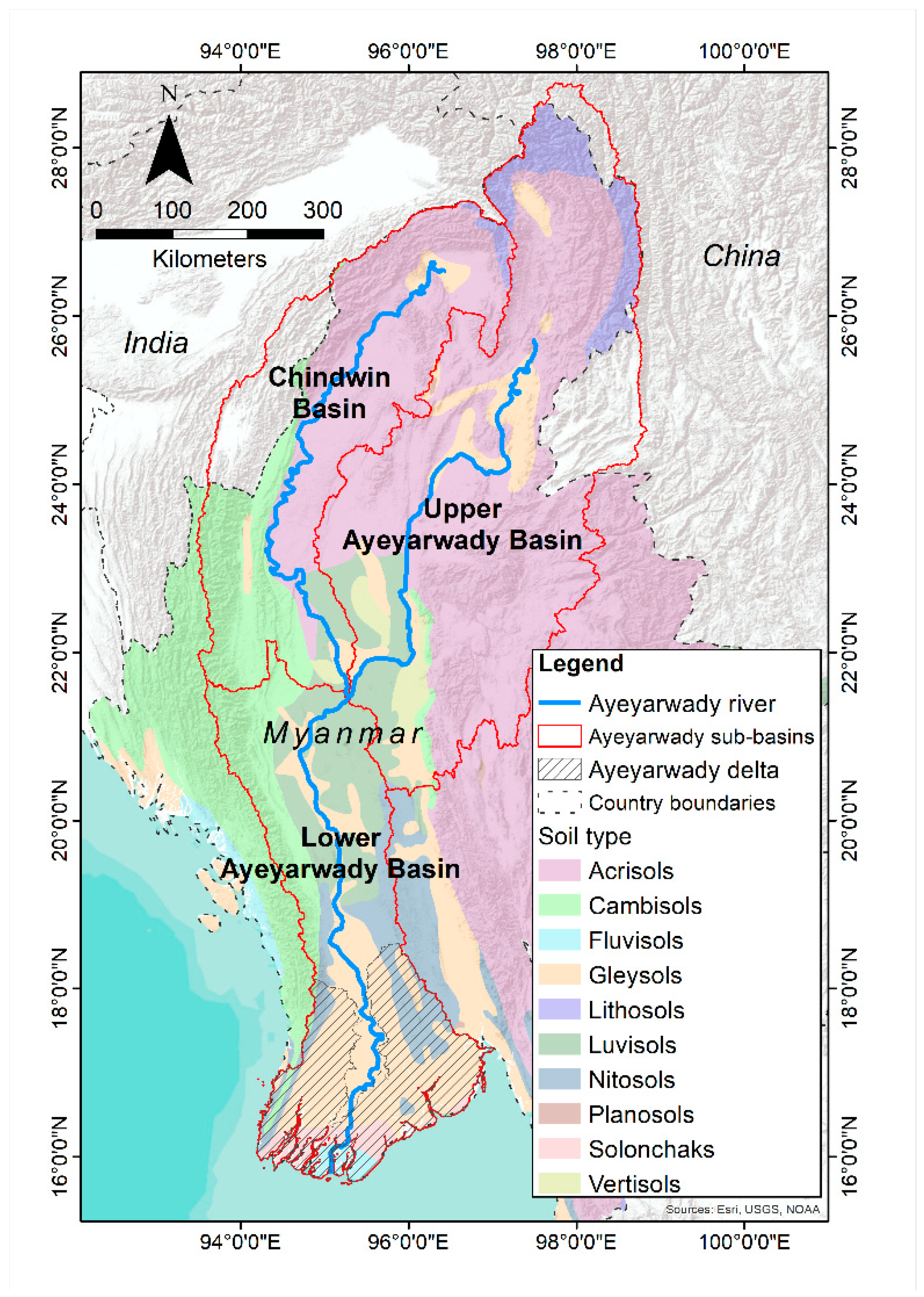
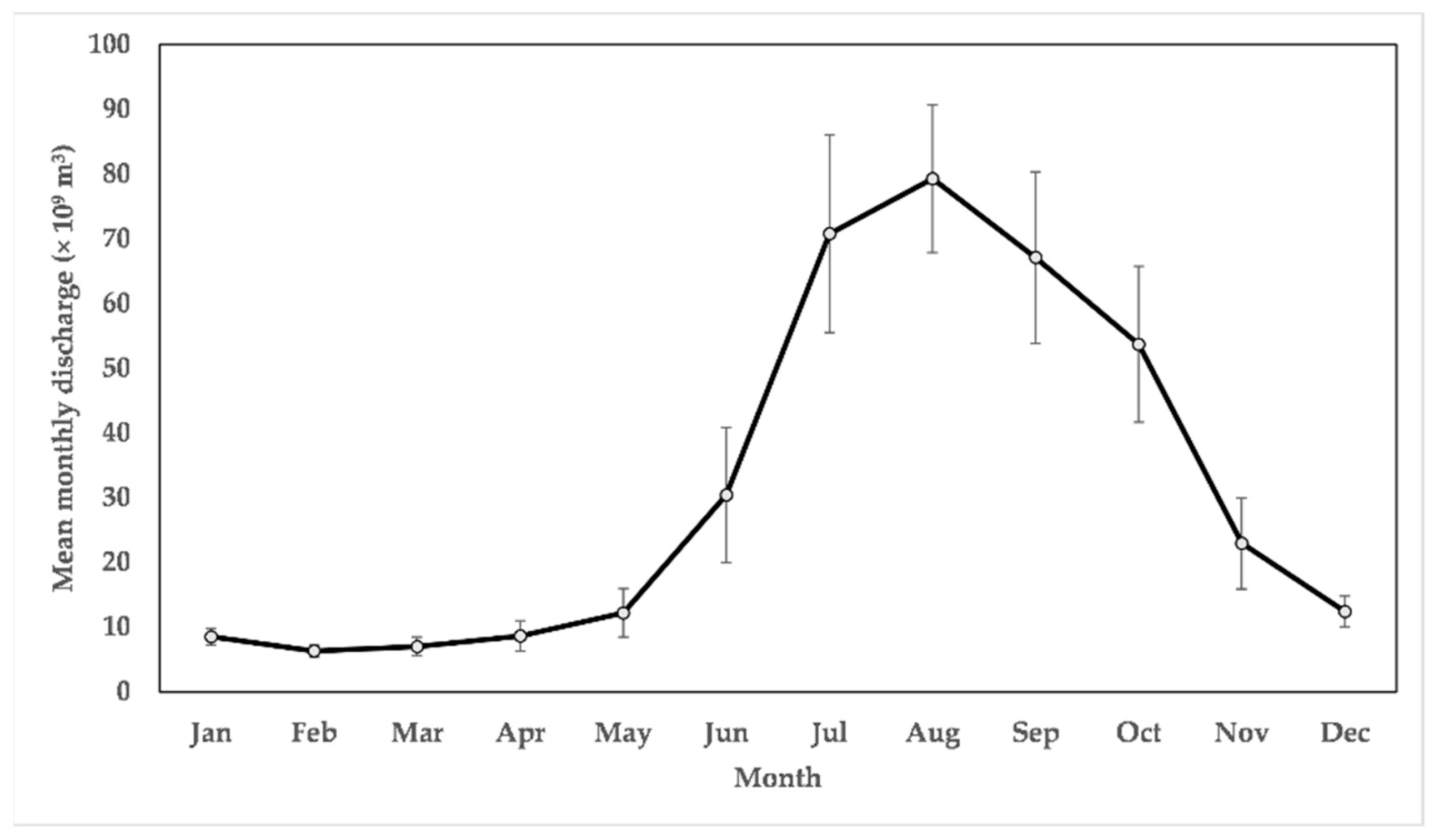
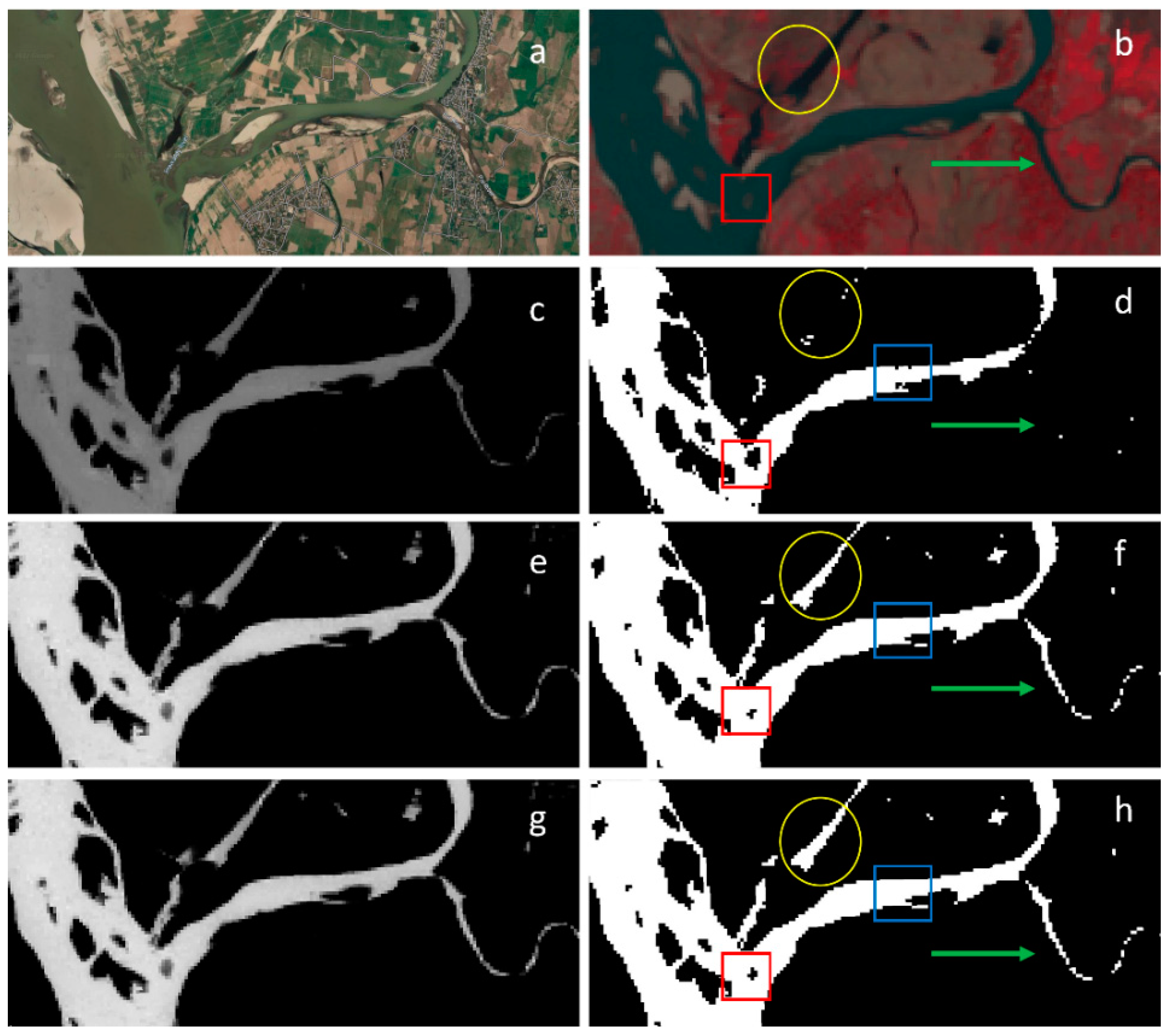
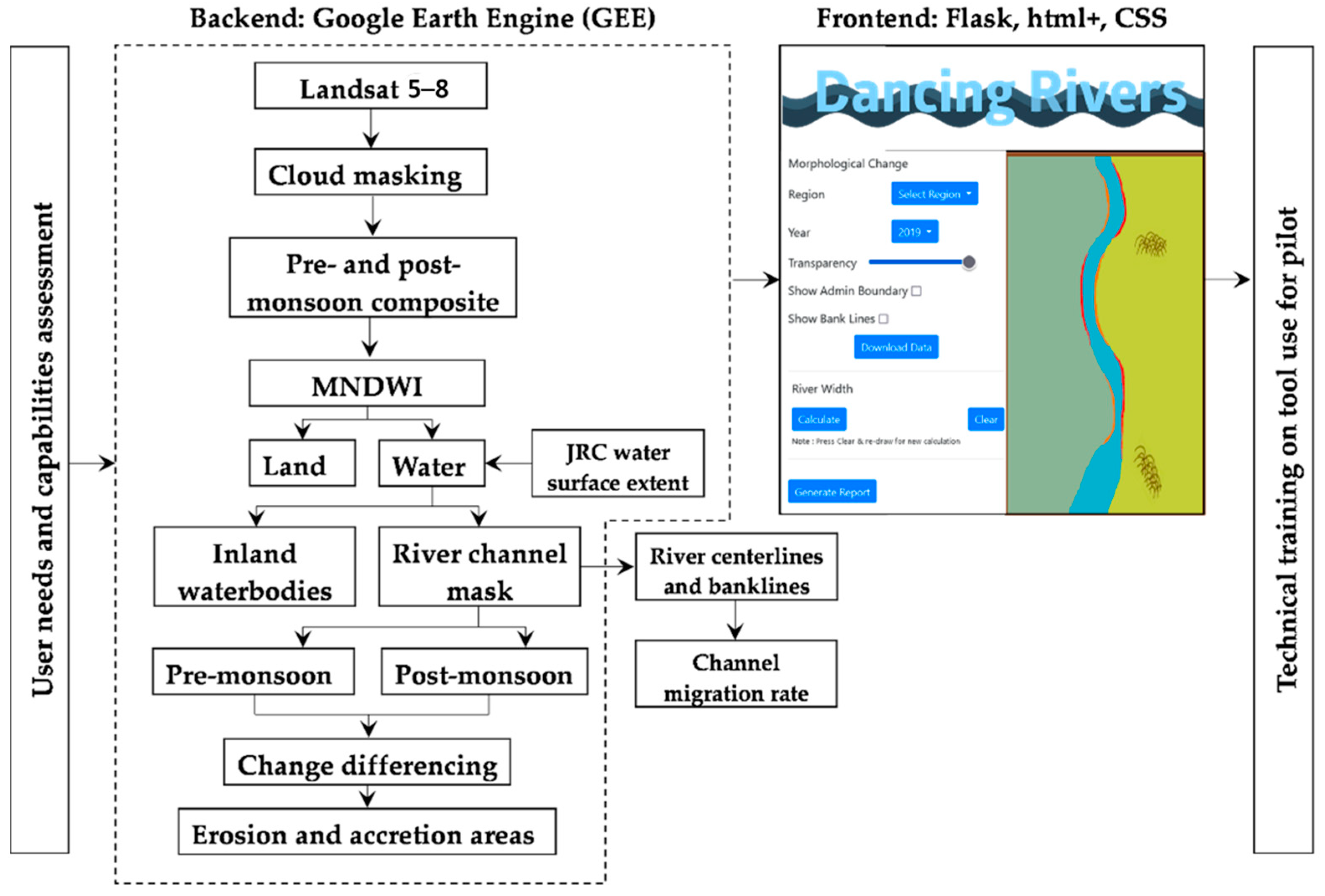
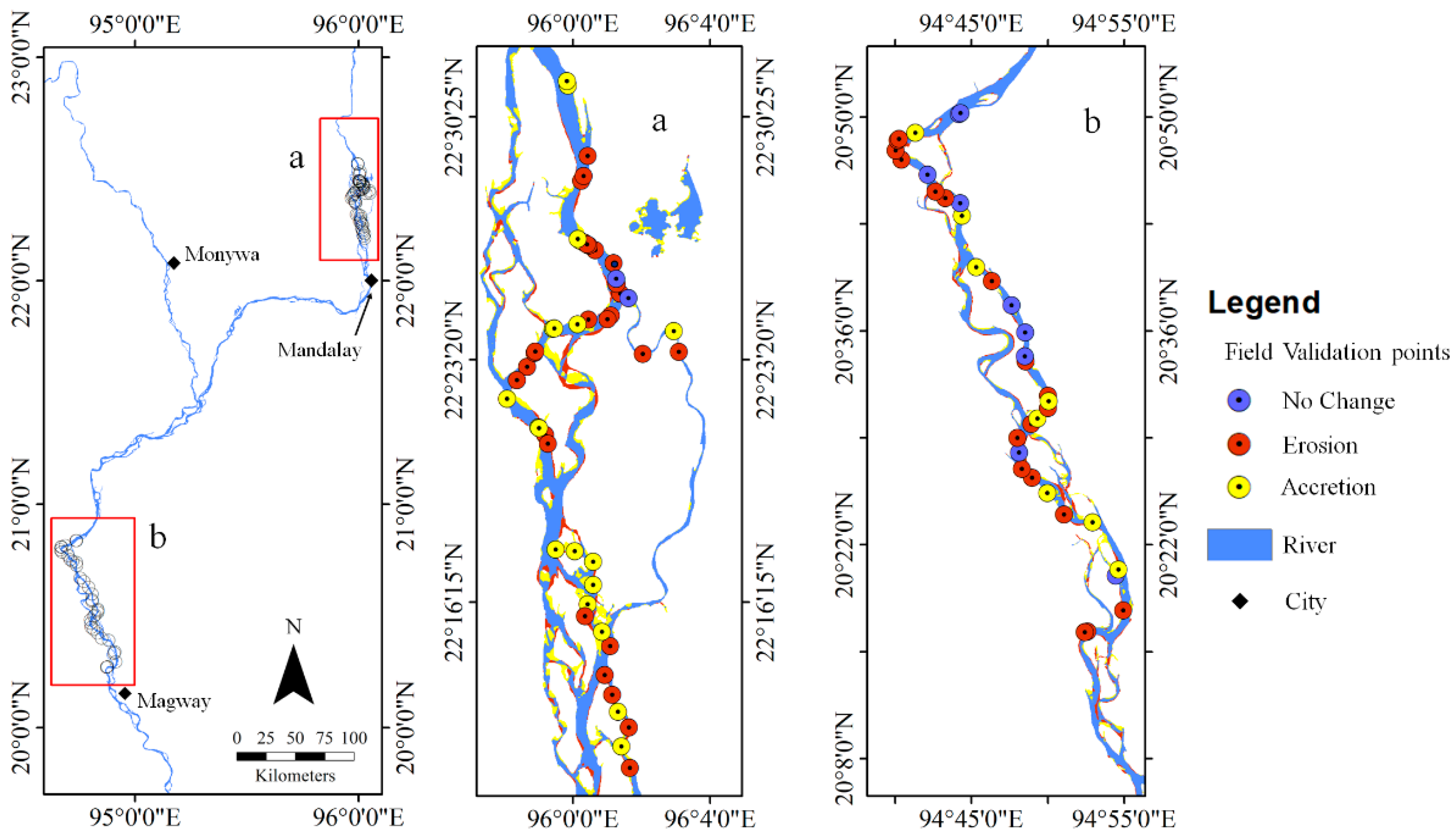
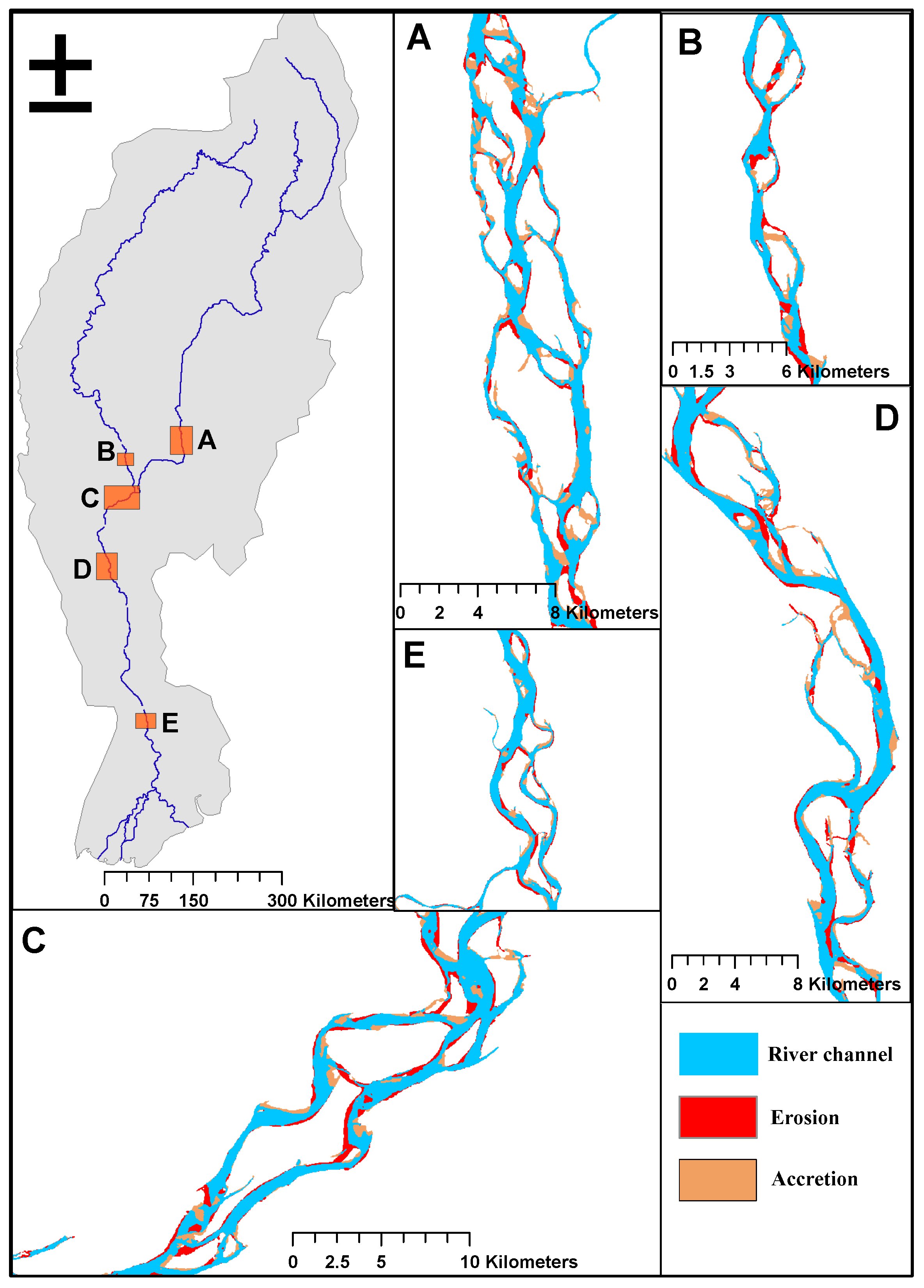
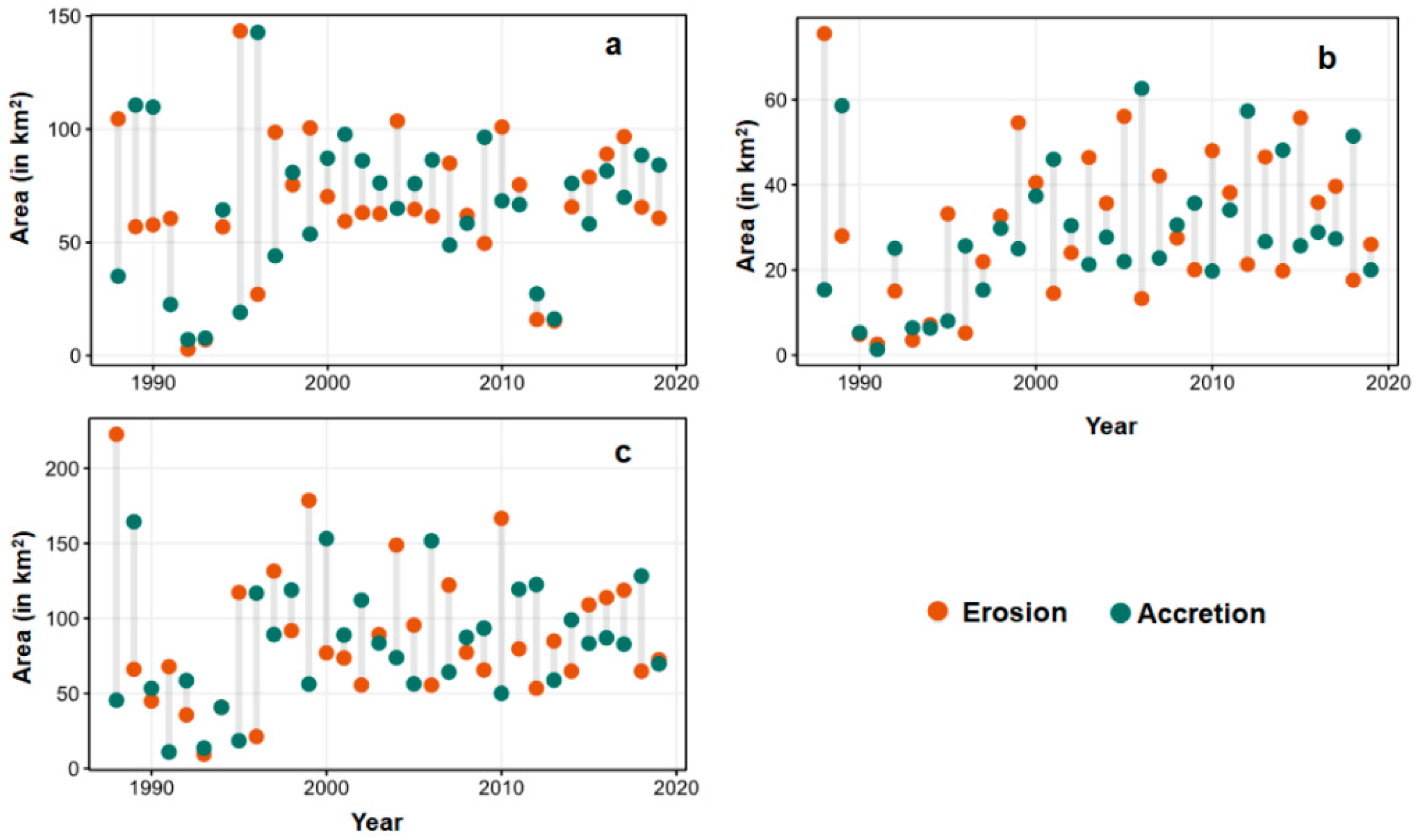
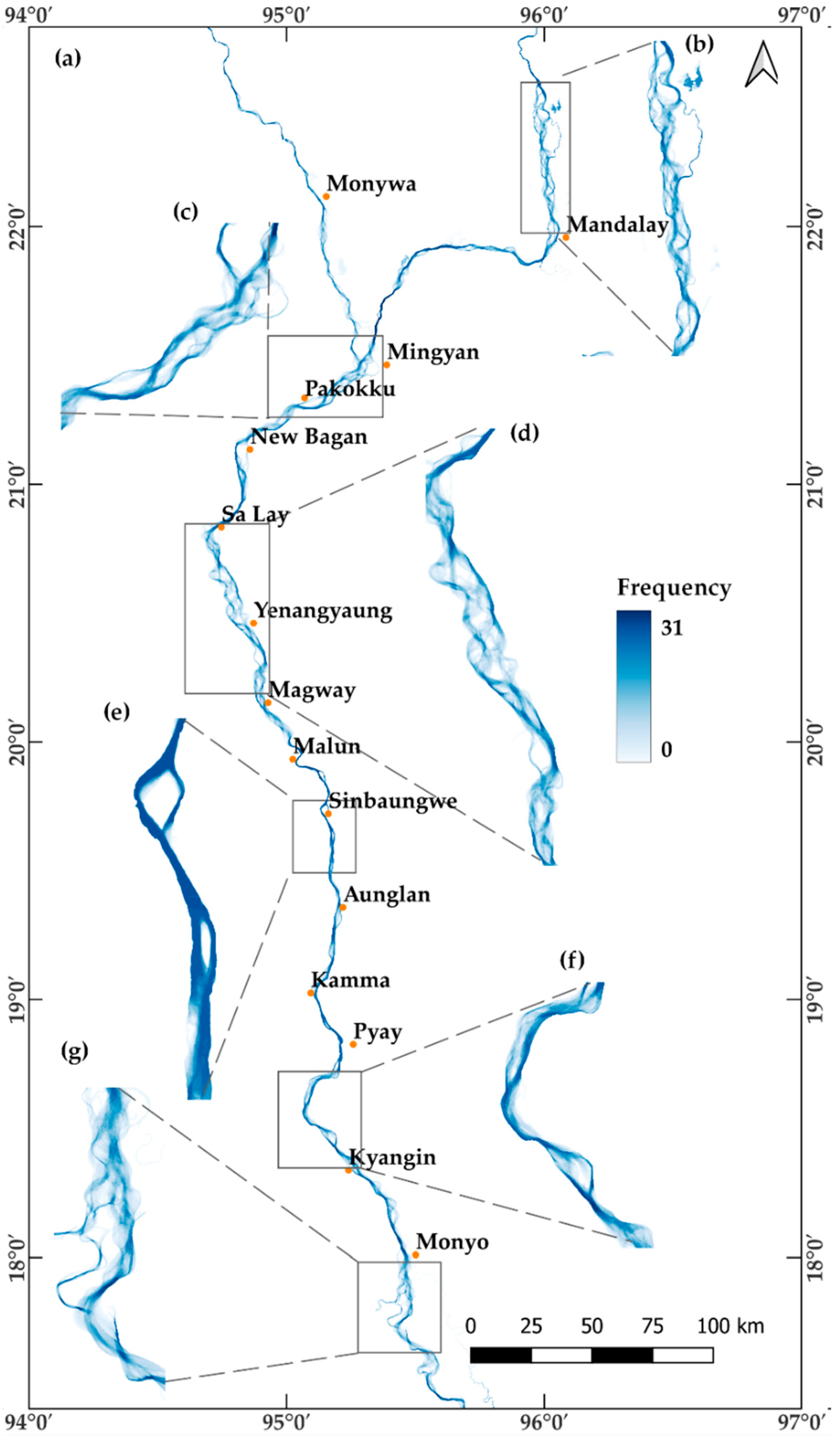
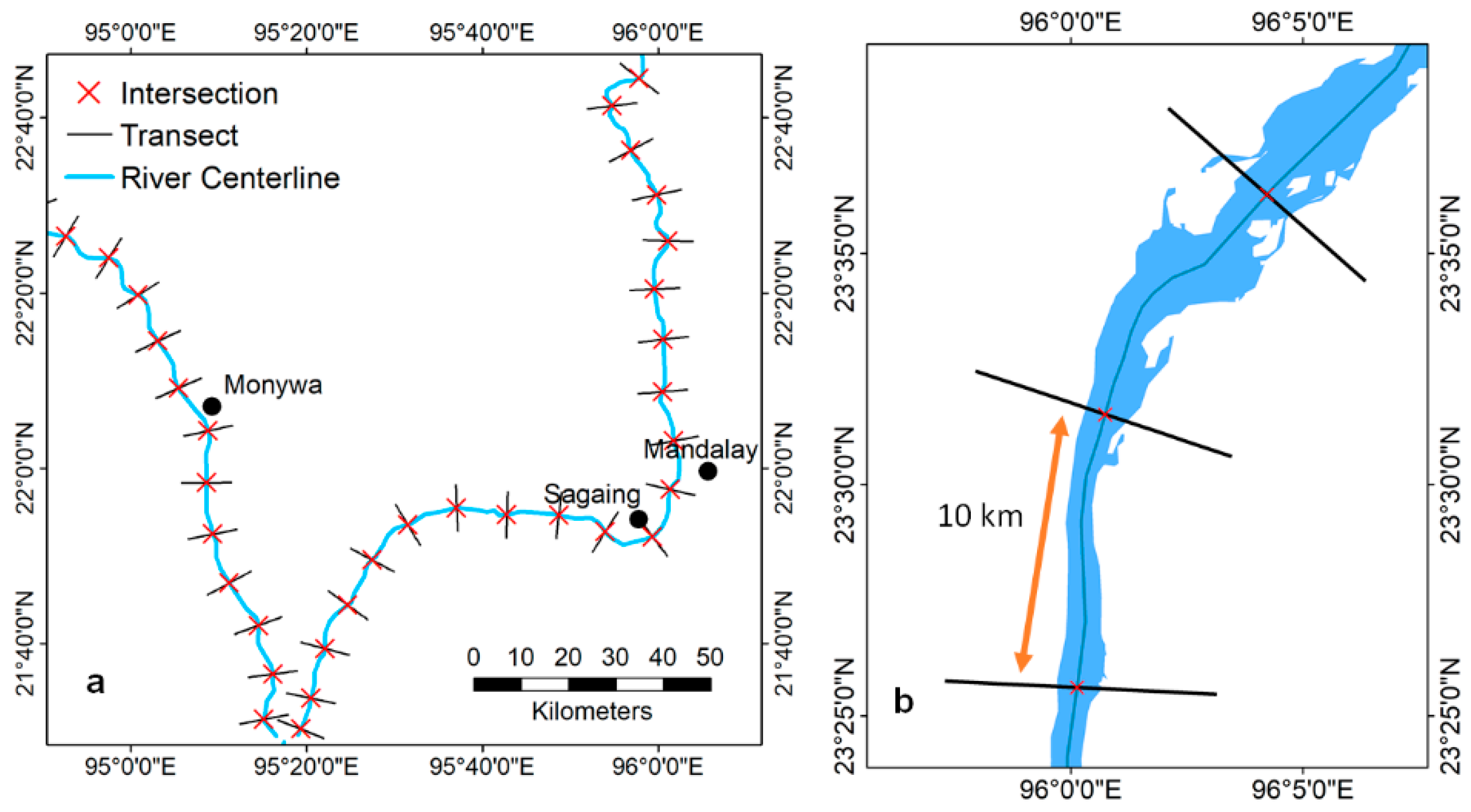
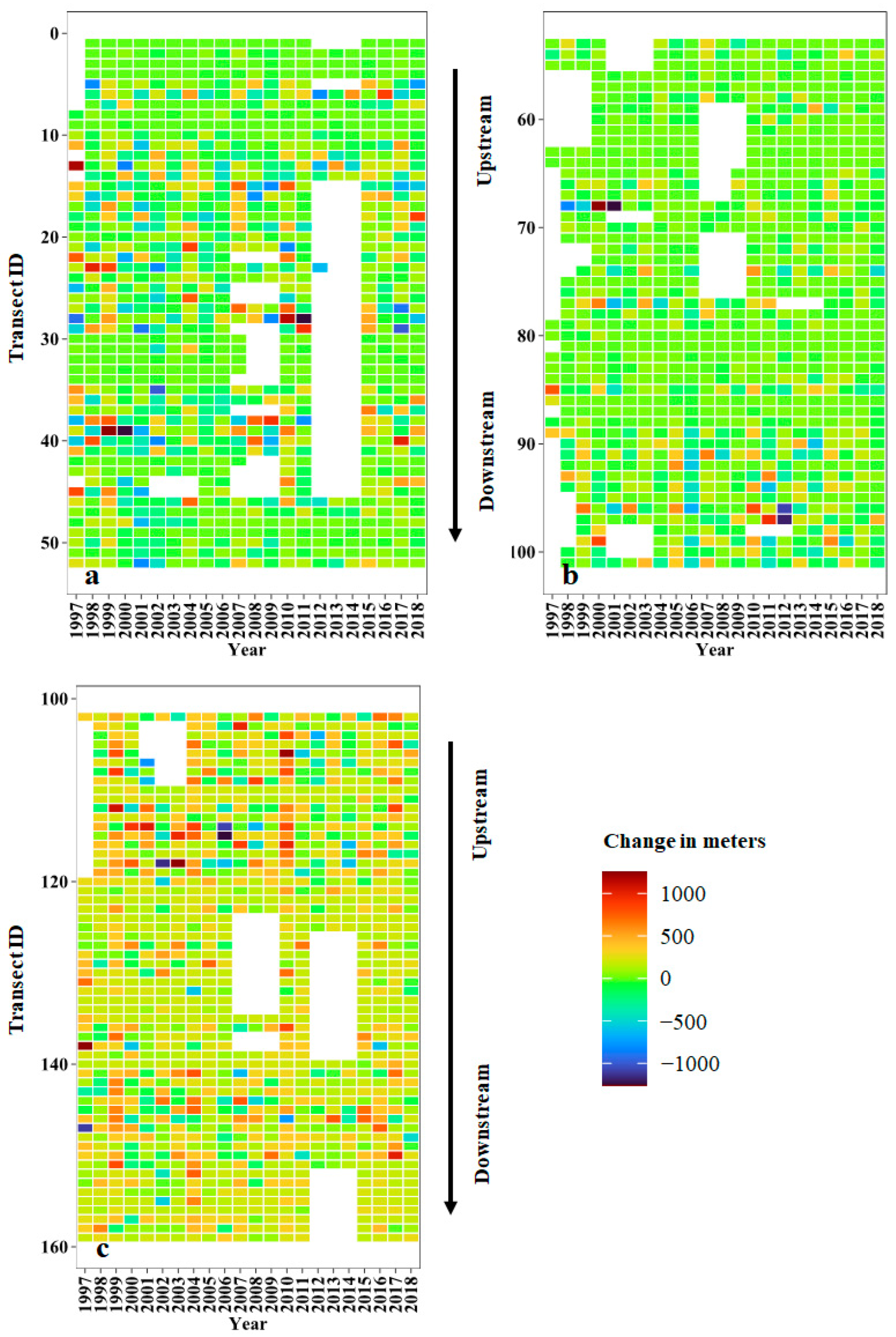

| Field Observation | ||||||
|---|---|---|---|---|---|---|
| Class | Erosion | Accretion | No Change | Row Total | User Accuracy (%) | |
| Satellite-Based Observation | Erosion | 41 | 3 | 1 | 45 | 91.11 |
| Accretion | 0 | 24 | 1 | 25 | 96 | |
| No change | 4 | 0 | 11 | 15 | 73.33 | |
| Col. total | 45 | 27 | 13 | 85 | ||
| Producer Accuracy (%) | 91.11 | 88.89 | 84.62 | |||
| Overall Accuracy | (41 + 24 + 11)/85 = 0.894 | |||||
Publisher’s Note: MDPI stays neutral with regard to jurisdictional claims in published maps and institutional affiliations. |
© 2022 by the authors. Licensee MDPI, Basel, Switzerland. This article is an open access article distributed under the terms and conditions of the Creative Commons Attribution (CC BY) license (https://creativecommons.org/licenses/by/4.0/).
Share and Cite
Bhatpuria, D.; Matheswaran, K.; Piman, T.; Tha, T.; Towashiraporn, P. Assessment of Large-Scale Seasonal River Morphological Changes in Ayeyarwady River Using Optical Remote Sensing Data. Remote Sens. 2022, 14, 3393. https://doi.org/10.3390/rs14143393
Bhatpuria D, Matheswaran K, Piman T, Tha T, Towashiraporn P. Assessment of Large-Scale Seasonal River Morphological Changes in Ayeyarwady River Using Optical Remote Sensing Data. Remote Sensing. 2022; 14(14):3393. https://doi.org/10.3390/rs14143393
Chicago/Turabian StyleBhatpuria, Dhyey, Karthikeyan Matheswaran, Thanapon Piman, Theara Tha, and Peeranan Towashiraporn. 2022. "Assessment of Large-Scale Seasonal River Morphological Changes in Ayeyarwady River Using Optical Remote Sensing Data" Remote Sensing 14, no. 14: 3393. https://doi.org/10.3390/rs14143393
APA StyleBhatpuria, D., Matheswaran, K., Piman, T., Tha, T., & Towashiraporn, P. (2022). Assessment of Large-Scale Seasonal River Morphological Changes in Ayeyarwady River Using Optical Remote Sensing Data. Remote Sensing, 14(14), 3393. https://doi.org/10.3390/rs14143393







